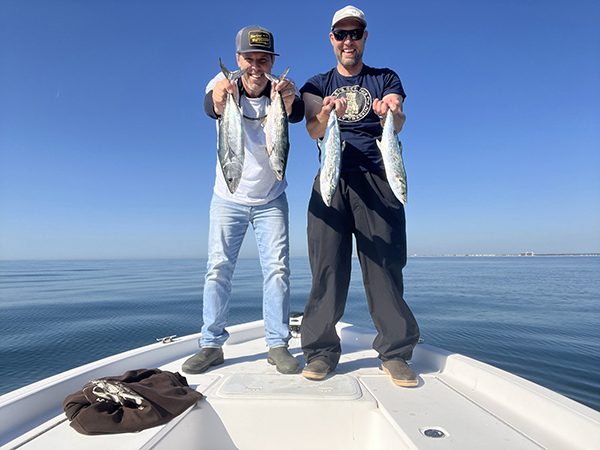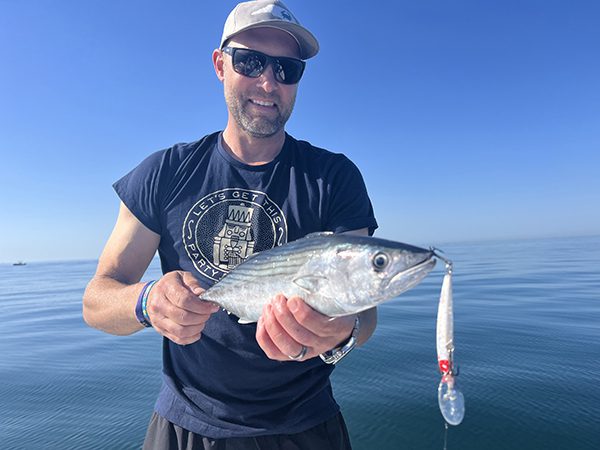Tidelines – May 2023
I believe I’m like most of you. I think it’s harder than it should be to put a fish in the boat.
Most of the time you see a photo of me in the newspaper holding up fish that I caught when on a trip with a local captain or guide, but when I go fishing on my own boat (a 22’ Seachaser), I can use all the help I can get. Thankfully, the Fisherman’s Post Weekly Inshore Fishing Reports & Forecasts are here to help, me included.
We started the Weekly Inshore Fishing Reports & Forecasts last year, providing them in audio and video delivery behind a pay wall ($10/month or $100/year), and now every week you can login and access 10 or so local captains and guides each giving a 5-8 minute report, a span that includes everywhere from North Myrtle Beach to Oregon Inlet.
The week before I needed a Tidelines article, I listened to Capt. John Berquist, out of Hatteras, letting our members know about sight casting to schools of big red drum and 30”+ bluefish just off the beach; Capt. Rob Koraly, out of Swansboro, talking about the big numbers of sea mullet and gray trout just inside the inlet and all along the Swansboro waterfront; and Capt. Tim Disano, out of Ocean Isle, telling everyone about the red hot black drum bite happening in area creeks.
However, since I’m located in Wilmington, it was Capt. Luke Moser, of Coastline Charters and reporting on Wrightsville Beach, that gave me a fishing plan for a potential Tidelines article.
The Weekly Reports & Forecasts are released every Thursday to help our members plan for the weekend ahead, and that’s how it worked for me, too. I had the benefit of Luke Moser’s intel in time for a Friday off work.

Gary Hurley and JJ Khoury with some of the spanish and bonito they caught trolling, casting, and jigging at the Liberty Ship. They were following information and direction provided by Capt. Luke Moser, of Coastline Charters, in the Fisherman’s Post Weekly Inshore Fishing Reports & Forecasts, including the Weekender Best Play.
Luke reported on the scattered bonito still in the area that were mixed in with a strong spanish mackerel bite. The instructions he gave everyone were easy to follow—head out of Masonboro Inlet to 30-50’ of water, especially near any structure, troll Clarkspoons and/or deep divers, and keep your eye out for fish busting but don’t be afraid to cast to areas you think are holding fish or drop down and jig areas where fish are showing on your machine.
The spanish and bonito not only made his report, but they were also part of his Weekender Best Play (each captain finishes his weekly report by offering up their best piece of advice for catching a fish in the upcoming weekend).
For Luke, his first suggestion was the improved sheepshead bite in the area, as he had seen a bunch of fish move in around area structure, such as bridges and docks closer to the inlets. While he led the Weekender Best Play with sheepshead, Luke was quick to follow with the logic that it was just so easy right now to catch keeper spanish that spanish fishing probably made the most sense “if you just want to catch fish.”
JJ, my brother-in-law, met me at the dock on Howe Creek, and we were on our way shortly after 5:30 am, hoping to clear Masonboro Inlet by 6:00. The “No Wake” zone by the boat ramp had us a little behind schedule, but we still saw just the hint of light on the horizon as we headed out to the Liberty Ship.
It takes a near-daybreak arrival at the Liberty Ship during bonito season to see the area with less than 5 boats. Three boats were anchored, two were on the troll, and JJ and I made it an even split by putting a couple of deep divers out, one set back to a 10 count and the other a 15-20 count.
Luke’s report was accurate. Almost as soon as we put out the deep divers, both rods were pulled down by our first two spanish of the day, a couple of nearly two-pound fish. We had our casting rods at the ready, again following Luke’s suggestion to have a mix of Stingsilvers and Gotcha plugs tied on, but we wanted to troll a little longer to see if there happened to be any bonito mixed in.
Spanish after spanish came to the boat, with the smallest measuring about 15” and the largest probably going 3 lbs., and while some bluefish found the hooks, mostly when we turned the boat and the speed of our troll dropped a little, we also picked at a couple of bonito—the true target species.
We dropped our Stingsilvers down a couple of times, but jigging only produced more spanish.
The 5 boats turned into 45 boats or so before long, but we kept catching fish by trolling on the outskirts of the fleet, with better success to the south and east than we had to the north or west. The water was calm, making it easy to see surface activity for a long way, so we headed in the direction of Mason’s Inlet thinking we might spot fish or birds or something to get us excited.
No fish. No birds. We headed in.

JJ Khoury, from Wilmington, with one of the bonito landed by trolling a deep diver at about 6 mph on the eastern outskirts of the Liberty Ship.
You would think that looking at the backside of the waves of Mason’s Inlet would have been the tricky part of the run, but the shifting and filling in that has happened inside the inlet was the hardest place to navigate (even with a relatively high tide, which doesn’t bode well for the summer sandbar parties).
Yes, I’m using Tidelines to pitch our Weekly Inshore Fishing Reports & Forecasts. Whether it’s fishing schools, fishing tournaments, a fishing newspaper, or now audio and video fishing reports, I like to think we do a good job with all of our offerings, and I ask you to give our weekly reports a try.
You can go to www.FishermansPost.com, click on Member Content, and then click on Premium Reports/Forecasts Registration. There you can get more information, check out highlight reels of all the recent reports, and/or register.
I’d like to end this article by telling you that this weekend I’m going to try out that sheepshead bite that Luke reported on, but chances are you’ll see a photo of me in the next issue holding up fish (or two or three) that I caught when back on a captain or guide trip.
Or maybe I’ll run a photo of a boat (or two or three) high and dry inside Mason’s on a busy Saturday.





